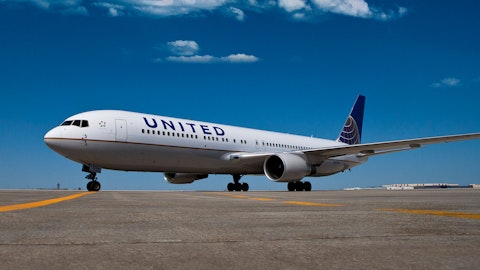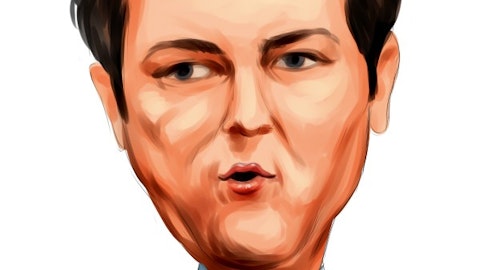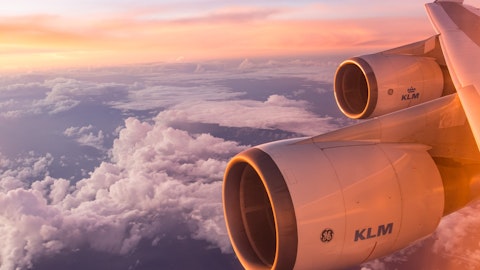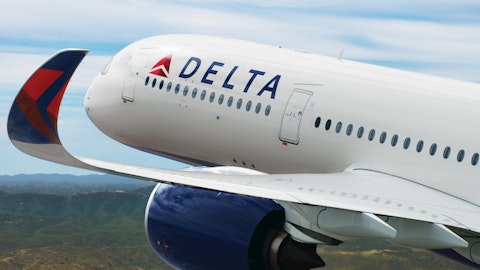Copa Holdings, S.A. (NYSE:CPA) Q3 2022 Earnings Call Transcript November 17, 2022
Copa Holdings, S.A. beats earnings expectations. Reported EPS is $2.91, expectations were $2.72.
Operator: Ladies and gentlemen, thank you for standing by. Welcome to the Copa Holdings Third Quarter Earnings Call. During the presentation, all participants will be on a listen-only mode. Afterwards, we will conduct a question-and-answer session . As a reminder, this call is being webcast and recorded on November 16, 2022. Now, I will turn the conference call over to Daniel Tapia, Director of Investor Relations. Sir, you may now begin.
Daniel Tapia: Thank you, Victor. And welcome everyone to our third quarter earnings call. Joining us today are Pedro Heilbron, CEO of Copa Holdings; and Jose Montero, our CFO. First, Pedro will start by going over our third quarter highlights, followed by Jose, who will discuss our financial results. Immediately after, we will open the call for questions from analysts. Copa Holdings financial reports have been prepared in accordance with International Financial Reporting Standards. In today’s call, we will discuss non-IFRS financial measures. A reconciliation of the non-IFRS to IFRS financial measures can be found in our earning’s release, which has been posted on the company’s Web site copaair.com. Our discussions today will also contain forward-looking statements, not limited to historical facts that reflect the company’s current beliefs, expectations and/or intentions regarding future events and results.
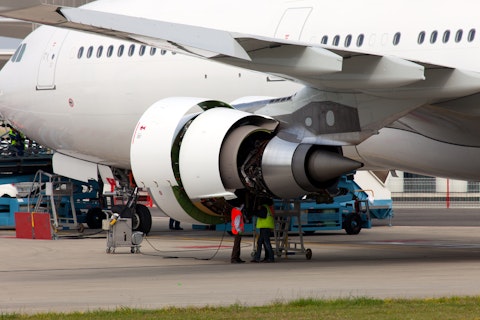
Alexey Y. Petrov/Shutterstock.com
These forward-looking statements involve risks and uncertainties that could cause actual results to differ materially and are based on assumptions subject to change. Many of these are discussed in our annual report filed with the SEC. Now, I’d like to turn the call over to our CEO, Mr. Pedro Heilbron.
Pedro Heilbron: Thank you, Daniel. Good morning to all, and thanks for participating in our third quarter earnings call. Before we begin, I’d like to thank all our co-workers for their commitment to the company and recognize their intense efforts and dedication to keep Copa at the forefront of Latin American aviation. To them, as always, my utmost respect and admiration. Despite the pressure that higher jet fuel prices continue to add to operating costs, in the third quarter, we were able to cover this increase, thanks to strong demand and unit revenue performance and lower ex fuel unit cost. During Q3, our effective fuel price per gallon increased by 77% compared to the same period in 2019, which drove a unit cost increase of 16%.
However, both our load factors and yields also increased improving unit revenues by 15% compared to Q3 2019, driven by a currently stronger travel demand environment in the region. The combination of these factors plus our ability to control our non-fuel related costs enabled us to deliver a 17.8% operating margin, which compares to an operating margin of 18.8% in Q3 2019. Now I would like to mention the main highlight for the quarter. Our capacity measured in ASMs reach ed99% of third quarter 2019, bringing us back to our pre pandemic levels. RPMs increased slightly by 1% compared to Q3 19, which led to an 86.8% load factor, a 1.2 percentage point improvement. Passenger yields came in at 14.01 cents or 12% higher than in the third quarter of 2019, while cargo revenue was 80% higher, resulting in unit revenues or RASM of 12.8 cents, a 15% increase compared to the third quarter of 2019.
Ex-fuel CASM decreased 5% compared to Q3 19 from $6.02 to $5.09. On the operational front, Copa Airlines delivered an on-time performance of 86.6% and a completion factor of 99.5%. Finally, in October, Copa earnings was recognized by the Skytrax for the seventh consecutive year as the Best Airline and Best Airline Staff in Central America and the Caribbean. I would like to remind you that earlier in the year, Copa was also recognized by Cirium as a most on-time airline in Latin America during 2021 for the eighth consecutive year. I’d like to take this opportunity to recognize and thank our more than 7,000 employees for everything they do day in and day out to offer a world best travel experience to our passengers. These awards prove that their continued efforts and commitment are specially valuable to our passengers and do not go unnoticed.
Turning out to our fleet. During the quarter, we took delivery of one Boeing 737 MAX 9 to end the quarter with a total of 95 aircraft compared to the 102 aircraft in our fleet pre pandemic. In terms of our network, in September, Copa Airlines started service to the Felipe Angeles International Airport, which complements our existing service to Mexico City. With the addition of this route, we continue strengthening and solidifying our position as the most complete and convenient hub in Latin America, ending the quarter with service to 77 cities in 32 countries. Turning out to Wingo. Wingo continues its regional expansion and by year end it expects to reach 31 routes with service to 20 cities in 10 countries. Furthermore, in the fourth quarter, Wingo will receive one additional 737 800 from Copa fleet to end 2022 with a total of nine aircraft.
To summarize, despite the current fuel price environment affecting the airline industry, we have reestablished our capacity and network back to pre pandemic levels and are consistently delivering improved financial results. Looking ahead, we observe a strong demand environment in the region and a healthy booking trend, which lead us to anticipate an increase in our unit revenues for Q4 and higher operating margins quarter over quarter. Nonetheless, considering the uncertainty of the current economic environment, we continue to closely monitor demand patterns in the region. So we will remain focused and flexible in terms of cost and capacity adjusting our plans as needed. I’d like to conclude by reiterating that we have a proven and strong business model, which is based on operating the best and most convenient network for intra-Latin America Travel from our Hub of the Americas, leveraging Panama’s advantageous geographic position with low unit cost, best on time performance and a strong balance sheet.
And we expect that our Hub of the Americas will continue to be a valuable source of strategic advantage. Now I’ll turn it over to Jose who will go over our financial results in more detail.
See also 12 Most Advanced Countries in Biotechnology and Lithium Stocks List: 15 Biggest Companies.
Jose Montero: Thank you, Pedro. Good morning, everyone. Thanks for being with us today. I’d like to join Pedro in acknowledging our great team for all their efforts to deliver world class service to our passengers. I will start by going over our third quarter results. Net profit for the quarter came in at $115.9 million or $2.93 per share. Excluding special items, profit came in at $115.1 million or $2.91 per share. Third quarter special items totaled approximately $900,000 comprised of an unrealized mark to market gain of $1.6 million to the company’s convertible notes and a $700,000 on realized mark to market loss related to changes in the value of financial investments. We reported a quarterly operating profit of $143.7 million and an operating margin of 17.8%.
Capacity came in at 6.3 billion available seat miles, which represents almost 100% of our Q3 2019 capacity. Load factor came in at an average of 86.8% for the quarter, a 1.2 percentage point increase compared to the same period in 2019, while passenger yields increased 12.1%. As a result, unit revenues came in at or 15% higher than in the third quarter of 2019. Driven by higher jet fuel prices, unit costs or CASM increased 16.4% compared to Q3 2019 to 10.5 cents. And finally, our CASM excluding fuel came in at 5.9 cents, a 5.3% decrease compared to Q3 2019. Although, we face certain inflationary pressures as well as higher sales and distribution unit costs related to higher sales levels, our continued initiatives to reduce our costs have reduced a sustained level of lower ex-fuel CASM.
I’m going to spend some time now discussing our balance sheet and liquidity. As of the end of the third quarter, we had assets of close to $4.6 billion. And in terms of cash, short and long term investments, we ended the quarter with $1.1 billion, which represents 42% of last 12 months revenues. As to our debt, we ended the quarter with $1.7 billion in debt and lease liabilities and our adjusted net debt to EBITDA ratio came in at 0.8 times. Turning now to our fleet. During the third quarter, we received one Boeing 737 MAX 9 to end the quarter with a total of 95 aircraft. In October, our total fleet increased to 96 aircraft since we received an additional 737 MAX 9. With this addition, our total fleet is now comprised of 68 737-800s, 19 737 MAX 9s and nine 737-700s.
These figures include one 737-800 freighter. Of our total fleet, two thirds of our aircraft are owned and one third is under operating leases. And for the remainder of the year, we expect to receive one additional 737 MAX 9, and so we expect to end the year with a fleet of 97 aircraft compared to 102 aircraft in our fleet at year end 2019. In 2023, we expect to receive 13 additional aircraft, 12 Boeing 737 MAX 9s and one Boeing 737 MAX 8. We’ve already secured financing for seven of these aircraft, one aircraft through a sale leaseback transaction and six through Japanese operating leases with call options. As to our outlook, based on the current strong demand environment, we can provide the following guidance for the fourth quarter of 2022.
We expect to operate approximately 6.5 billion ASMs, which implies a capacity increase of 6% compared to Q4 2019, and we expect an operating margin of approximately 22%. We’re basing our Q4 2022 outlook on the following assumptions; load factor of approximately 88%; unit revenues of approximately 13.7 cents; CASM ex-fuel of approximately 6 cents; and an all-in fuel price of $3.75 per gallon. Regarding next year, based on our current fleet plan, we expect our capacity measured in ASMs to increase approximately 15% versus that of 2022. Thank you. And with that, we’ll open the call to some questions.
Q&A Session
Follow Copa Holdings Sa (NYSE:CPA)
Follow Copa Holdings Sa (NYSE:CPA)
Operator: Thank you . Our first question comes from the line of Duane Pfennigwerth from Evercore ISI.
Duane Pfennigwerth: I wanted to ask you about competitive capacity. This analysis gets a little noisy with everything comp year over three year and versus 2019. But if we actually look year-over-year, it looks like Central America to the US is one of a few regions in the world where capacity is actually down year-over-year. So I wonder if you could just comment broadly on what you are seeing from a competitive capacity perspective in your markets in the fourth quarter versus the third quarter?
Pedro Heilbron: So Central America to the US could be down, but it was higher right after the pandemic. So it’s coming back to a more normal level in a way we could say that. The main airlines in our region, the main international airlines will be back to nearly the pre pandemic capacity by the end of this year, so by the end of Q4 22, and then the new entrants and the OCCs are above pre pandemic.
Duane Pfennigwerth: And then on dividend policy, apologize if you mentioned this. but how are you and the board thinking about restoration of the dividend and kind of the historical payout, and how do you think about buybacks versus dividends here? Obviously, you’ve done a substantial amount of buyback already and an incredible amount of buyback for an airline.
Pedro Heilbron: So the dividend policy, it’s still there. It was suspended when the pandemic started. And to be reactivated, it’s a decision that Board must take. And I am assuming that’s going to be discussed in the next board meeting after Q4 closes.
Jose Montero: Duane, and in terms of the buyback, as you mentioned, yes, we’ve been active. We have an active program of $200 million that is not yet completed. And rationale for the program is, A, as we’ve always had to maximize shareholder value, but also as a tool to have some management of the liability related to the convert. So that’s kind of the rationale of the buyback program that we’ve been executing.
Operator: Our next question comes from the line of Alejandro Zamacona from Credit Suisse.
Alejandro Zamacona: My first question is on the expectations for 2023. So besides the capacity load of 15% that you disclosed, do you have any early expectations in terms of yield, fuel costs, profitability, especially for yields, assuming that oil prices have started to normalize and for costs a the high inflationary environment.
Jose Montero: We issued our preliminary guidance just in terms of capacity at this time. And I think that will probably have more visibility into 2023, and so we’ll hold on until then for a clearer, more comprehensive guidance for the full year.
Pedro Heilbron: And we’ll have more visibility on the specific factors you have mentioned for sure.
Alejandro Zamacona: And then my second question, if I may, regarding the labor union negotiations. Could you share any thoughts on the current negotiations and expected outcome?
Pedro Heilbron: We have four main unions, earlier in the year, we closed negotiations with the airport workers and the mechanics, and we’re currently in negotiations with the pilots and in the final stage with the cabin crews. So I would not like to speculate on results.
Operator: One moment for our next question. Our next question comes line Michael Linenberg from Deutsche Bank.
Michael Linenberg: Good results, by the way. Great outlook, too. Couple here. Jose, just back on the share repurchase, it looks like this last quarter, maybe it was a little over $20 million. The previous quarter, maybe it was $120 million, $125 million. If I think about what, $200 million in total, what do we have about $50 million left, $60 million. Can you just give us what’s left in the program?
Jose Montero: No, it’s a little bit more because there is a portion of what we purchased in the second quarter that was associated with the prior program that we had. So there’s a little bit north, I think, about $100 million left in the current program.
